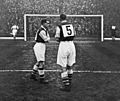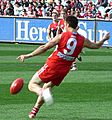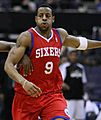Number (sports) facts for kids

In team sports, a uniform number (also called a squad number or jersey number) is a number worn on a player's uniform. It helps to tell each player apart from others on the same team. This is super important for officials, people keeping score, and fans watching the game.
The number is usually on the back of the player's jersey. Sometimes, the player's last name is written above or below the number. You might also see the number on the front or sleeves of the jersey, or even on a player's shorts or helmet.
Contents
Why Do Players Wear Numbers?
Imagine trying to follow a game with 22 players on a field, all wearing the same color! It would be really hard to know who's who. That's why uniform numbers are so helpful. They make it easy to:
- Identify players: Quickly tell one player from another.
- Track stats: Keep track of who scores points or makes plays.
- Help officials: Make sure the right player gets credit or a penalty.
- Connect with fans: Fans often have favorite players and remember them by their numbers.
A Quick History of Numbers in Sports
Players haven't always worn numbers. It took a while for them to become common!
Early Days of Numbering
- First uses: One of the earliest times numbers were used was in association football (soccer) in Australia in 1911.
- Baseball's start: In Major League Baseball (MLB), the Cleveland Indians were the first team to try numbered uniforms in 1916.
- Soccer in England: Numbers first appeared in English soccer in 1928, but they didn't become a rule until 1939.
- South America: In South America, numbers were first used in a game in Argentina in 1923.
Numbers Become Standard
Over time, more and more sports started using numbers. By the mid-20th century, numbers were a normal part of almost every team sport around the world.
Numbers in Different Sports
The way numbers are used can be different depending on the sport.
American Football
- In American football, numbers often show what position a player plays. For example, quarterbacks usually wear numbers from 1 to 19.
- Unlike Canadian football, American football usually doesn't allow the number 0.
Association Football (Soccer)
- In soccer, players often wear numbers from 1 to 11 for starting players, with 1 usually being the goalkeeper.
- Players often keep the same number for a whole season.
- Sometimes, a player's number becomes famous, like when a team "retires" a number so no one else can wear it.
Basketball
- In basketball, players can usually pick numbers from 0 to 99.
- Teams often retire numbers of their best players, meaning no one else on that team can ever wear that number again. This honors the player's achievements.
Ice Hockey
- In ice hockey, players also pick numbers, and some numbers become very famous.
- The number 1 used to be common for goalies, but it's less common now.
Other Sports
- Australian Rules Football: Numbers are usually not linked to a player's position.
- Rugby Union: Numbers are often linked to specific positions, like the fly-half wearing number 10.
- Motor Sports: Race cars and motorcycles also have numbers to identify them during races. Sometimes these numbers can have letters too.
Special Numbers and Traditions
Sometimes, numbers become very special in sports.
- Retired Numbers: When a team retires a number, it means a player was so important that their number will never be used by another player on that team again. It's a huge honor!
- Un-issued Numbers: Very sadly, sometimes a number is not used again after a player passes away, especially if it was due to a tragic accident during the sport.
- Player Choice: In many sports, players get to choose their own numbers, which can be numbers that are lucky for them or have a special meaning.
- Changing Numbers: Sometimes players change their numbers, like when a new teammate arrives who already has their number.
Uniform numbers are a small but important part of sports, helping to make games clear and exciting for everyone!
Images for kids
-
The first time numbers were used in South America: Scottish club Third Lanark and Argentine "Zona Norte" combined entering the field with numbered jerseys, June 10, 1923.
-
Players of the Cleveland Indians wearing uniforms with numbers on their left sleeves in 1916. The Indians were the first team in the MLB to use numbered uniforms.
-
Even though the NBA doesn't let players change numbers during the season, Andre Iguodala switched from #4 to #9 when Chris Webber joined the Sixers in 2005.
-
English cricketer Ben Stokes wearing 55 in a One Day International match against New Zealand, 2015. Players can often choose their own numbers.
-
Goaltender Jacques Plante's No. 1 jersey displayed at the Hockey Hall of Fame. Over time, the number 1 became less common for goalies.
-
Jeff Burton's car wearing No. 31 (2013).
-
Jody Scheckter racing with No. 3 in 1976.
-
Jules Bianchi's No. 17 has not been used again after he died in 2015 from an accident at the 2014 Japanese Grand Prix.
-
Start of a motocross race; a racer with a 3-digit number is in the lead.
-
Fly-half Dan Carter wearing n° 10, a number usually given to players in that position.
-
Number 21 on the road bicycle of Ellen van Dijk at the Ronde van Drenthe.
-
Los Angeles Lakers retired numbers shown at the Staples Center in 2013.
See also
 In Spanish: Numeración deportiva para niños
In Spanish: Numeración deportiva para niños


















